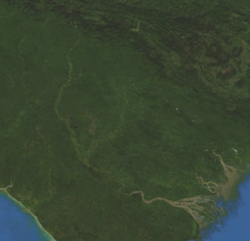Upper Fly River
| Fly | |
| River | |
|
NASA Blue Marble satellite image of the Fly River
|
|
| Countries | Papua New Guinea, Indonesia |
|---|---|
| Tributaries | |
| - left | Strickland River |
| - right | Ok Tedi River |
| Source | |
| - location | Star Mountains, Papua New Guinea |
| Mouth | |
| - location | Gulf of Papua, Papua New Guinea |
| Length | 1,050 km (652 mi) |
| Basin | 76,000 km2 (29,344 sq mi) |
| Discharge | |
| - average | 6,000 m3/s (211,888 cu ft/s) |
| Discharge elsewhere (average) | |
| - | 6,000 m3/s (211,888 cu ft/s) |
|
Location of the Fly
|
|
The Fly, at 1,050 kilometres (650 mi), is the second longest river in Papua New Guinea, after the Sepik. The Fly is the largest river in Oceania, the largest in the world without a single dam in its catchment, and overall ranks as the 25th-largest river in the world by volume of discharge. It rises in the Victor Emanuel Range arm of the Star Mountains, and crosses the south-western lowlands before flowing into the Gulf of Papua in a large delta.
The Fly flows mostly through the Western Province, though for a small stretch it forms the boundary between Papua New Guinea and the Indonesia province of Papua. This section protrudes slightly to the west of the 141°E longitude line. To compensate for this slight gain in territory for Papua New Guinea, the border south of the Fly River is slightly east of the 141°E longitude line. As part of this deal, Indonesia has the right to use the Fly River to its mouth for navigation.
The principal tributaries of the Fly are the Strickland and the Ok Tedi.
Close to its mouth, the flow of the Fly River encounters a tidal bore, where an incoming high tide pushes water upstream until the changing of the tide. The range of this tidal bore is still undocumented.
The delta of the Fly River is over 100 km wide at its entrance, but only 11 km wide at the apex upstream of Kiwai Island. The delta contains 3 main distributary channels (the Southern, Northern, and Far Northern Entrances) that branch from a common point (the “apex”). The distributary channels are 5 to 15m in depth, separated by elongate, sand-mud islands that are stabilised by lush mangrove vegetation. The islands are eroded and rebuilt rapidly in the apex area, where they have lateral migration rates of up to 150 m/a, with slower rates for the more seaward islands. Upstream from the apex the river gradually narrows to a width of 1.6 km or less. The Fly Delta exhibits a distinctive funnel shape in plan view, attesting to the fundamental role of tidal currents in shaping the Delta's geomorphology. Mean spring tidal ranges are amplified within the delta, from around 3.5m at the seaward entrance of the distributary channels, reaching a peak of about 5m at the delta apex. Seismic profiles and radiometrically dated core samples indicate that the delta is prograding seawards at an average rate of about 6 m/a
...
Wikipedia


